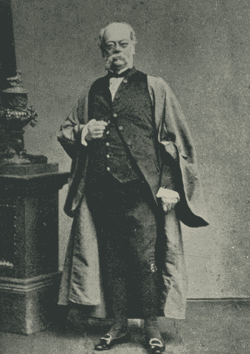Henry MacManus, Historical and Figure Painter
(b. about 1810, d. 1878)
Historical and Figure Painter
From A Dictionary of Irish Artists 1913

Henry MacManus, R.H.A. Photograph.
Was born about 1810, but of his early life little is known. In 1835 he was living in Monaghan, and in that year sent his first contribution to the Royal Hibernian Academy. In 1836 he became a Member of the Association of Artists instituted at Belfast in that year. In 1837 he went to London where he remained until 1844, and he exhibited at the Royal Academy, the British Institution and the Old Water-colour Society from 1839 to 1843. Among his exhibited works were "May-day at Finglas, Co. Dublin," R.A., 1839, and "An Irish Market-day, Ballybay, Co. Monaghan," R.A., 1841. In 1845 he was appointed head master of the Glasgow School of Design, and he remained there until 1849, when, on the Schools of the Dublin Society being converted into a School of Design under the Board of Trade, he was appointed head master. As a teacher he is said to have been successful, having the faculty of developing the talents of his pupils and inspiring them with interest and enthusiasm. During his term of office evening classes were established, as also day classes for women. He retired in 1863 and was presented with an address and a silver palette by the students in the school. The Royal Dublin Society made him its Honorary Professor of the Fine Arts.
MacManus was a constant exhibitor in the Royal Hibernian Academy from his first appearance in 1835 down to the year of his death, though in his latter years irregularly. He was elected an Associate in 1838 and a full Member in 1858; and for the last five years of his life was professor of painting. He was an enthusiast in his art; but although his early works display some merit, his pictures, as a whole, were poor in colour, and in his latter years became puerile and even ludicrous. Two pieces of sculpture by him, "A Bacchante Reposing" and "Topsy," both in plaster, were in the Dublin Exhibition of 1853. Among his pictures were: "Irish Pilgrims at a Station" (R.H.A., 1843); "Irish Assizes," "Donnybrook Fair," and "Patrick Street, Dublin" (R.H.A., 1838); "Rory O'More" (B.I., 1840); "Nell Gwyn pleading with Charles II to found Chelsea Hospital" (B.I., 1841); "Thomas a Beckett refusing to sign the Constitutions of Clarendon," a cartoon exhibited at Westminster Hall in 1843. In the Dublin Exhibition of 1853 was a large picture, 17 feet by 12 feet, of "St. Patrick expounding the Trinity at Tara." This picture was favourably noticed in the "Art Journal," 1853, as "a work of considerable merit. The grouping and general arrangement of the picture call for high praise; the colouring is by no means glaring, and the story is told with force and effect." MacManus painted portraits of "William Carleton" (R.H.A., 1837); "Isaac Butt" (1837); and one of "Mrs. S. C. Hall," which was engraved by T. Ryall and published by Graves, London, in 1841.
A sketch of Mrs. Hall was etched by John Kirkwood for the "Dublin University Magazine," Vol. XVI, 1840; and one of "Admiral Stopford" in Vol. XX, 1842. "The Conspirators, or Repeal Martyrs of 1843," a sheet of oval portraits of O'Connell, Duffy, Steel and others, was lithographed by W. H. Holbrooke. MacManus did numerous drawings for book illustrations; sixteen appear in Hall's "Ireland, its Scenery and Character," and others in Carleton's "Traits and Stories of the Irish Peasantry," and in "Bob Norbury, or Sketches from the Notebook of an Irish Reporter," 1844.
In spite of certain faults of manner and disposition, MacManus was much liked by all who knew him for his pleasant and kindly nature. He died at his residence, 2 Leinster Terrace, Dalkey, on 22nd March, 1878, aged 68 years, and was buried at Enniskerry.
« Daniel Maclise | Contents and Search | George McQuestion »
